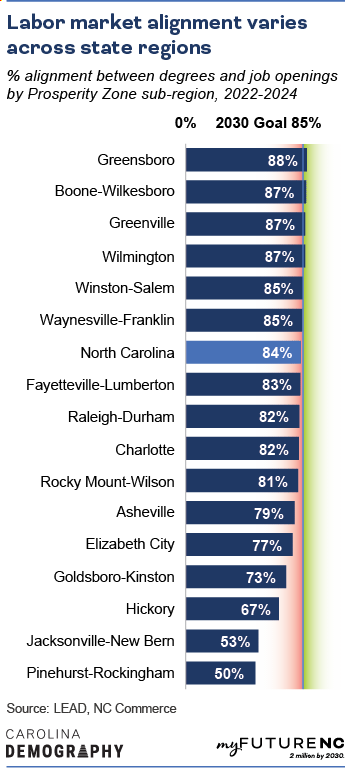Alignment between the skills of college graduates and the needs of North Carolina employers
* Demographic group segmentation not available for this indicator
Data year: 2022-2024 (average)
= Top southern state :
only available for totals, not available for all indicators
What does Labor Market Alignment mean?
Alignment between the skills of graduates and the needs of employers.
What does this data show?
North Carolina’s labor market alignment was 84% in the most recently available data, meaning that more than eight of every ten graduates from state postsecondary institutions had skills and credentials aligned with job openings.
By 2030, the goal is that North Carolina’s labor market alignment rate will be 85%.
Why does Labor Market Alignment matter?
Employers in some sectors in North Carolina already struggle to fill vacancies, and, as the myFutureNC Call-to-Action noted, “as many as half of the occupations available today are projected to transform significantly in the coming years, increasing demand for workers with technical and highly employable skills.”
Labor market alignment represents how well-matched the supply of graduates is with the demand of job openings. A rate of 100% means that the distribution of credentials awarded by postsecondary institutions is perfectly aligned with job openings: all degrees and credentials conferred are in demand in the job market. A rate of 0% means that there is complete misalignment between degree production and job demand—graduates have skills that are not in demand by any employer.
Higher labor market alignment rates mean that graduates leave postsecondary with skills and credentials that increase their probability of job market success. Declines in labor market alignment pose challenges for the state and its residents: employers have trouble hiring—and graduates have trouble finding work—when there is a mismatch between the needs of employers and the skills of the graduates.
Having labor market data allows colleges to develop programs tailored to projected job opportunities and to evaluate existing programs for current and projected labor market conditions.
How is North Carolina performing?

The alignment between locally awarded postsecondary degrees and credentials and job openings varies significantly across the state’s Sub-Prosperity Zones (“regions”). In the Pinehurst-Rockingham region, for example, 50% of postsecondary degrees and credentials awarded were aligned with job openings, the lowest rate in the state. In contrast, 88% of degrees and credentials in the Greensboro region were aligned with regional job openings, the highest rate statewide and meeting our state goal.
Most regions, however, had labor market alignment rates below the state average. While the state’s overall production of degrees and credentials is well-aligned with broad labor market needs, the distribution within specific regions of the state is less aligned. This indicates that individuals who graduate within a region may need to move elsewhere in the state or commute longer distances to find a job aligned with their skills. Likewise, an employer might not be able to find recent graduates with the skills they need within that region.
myFutureNC is working with the Labor and Economic Analysis Division at NC Commerce to develop comparison metrics to other states.
Methodology
Where does the data for labor market alignment come from?
Data on labor market alignment is provided by the Labor and Economic Analysis Division at North Carolina’s Department of Commerce (LEAD).
The supply of graduates was calculated using credential counts from the National Center for Education Statistics’ Integrated Postsecondary Education Data System (IPEDS). IPEDS provides survey-based counts of the number of credentials awarded by campus, program, and degree level. Data are published comprehensively (without suppression) for both public and private institutions. LEAD uses the location of each campus to identify where graduates are being “supplied.”
Workforce demand was determined by the number of job openings. LEAD uses online job postings from the Conference Board and adjusts these counts using data from the Bureau of Labor Statistics’ Job Openings and Labor Turnover Survey to account for job openings that are underrepresented on online job boards.
How was the data calculated?
LEAD used the New York Fed’s mismatch index methodology to measure the alignment between supply and demand. Full details on this methodology are available here.
Who is included?
Postsecondary awards, certificates, diplomas, and degrees awarded by postsecondary institutions in North Carolina.
Who isn’t included?
Third-party credentials and licenses are not captured in IPEDS.
Data sources used in the development of this indicator are derived from surveys and administrative records and are subject to sampling and non-sampling error.
Learn more
Who is working on this in NC?
Help improve this section
If you know of an organization that is working on this topic in NC, please let us know on the feedback form.
Name: Local Workforce Development Boards
Scope: Statewide association with local development boards
Website: https://www.ncawdb.org
About: Local Workforce Development Boards are the conveners of the workforce system on a local level in the state of North Carolina. They are business-led and supported by local elected officials. The Boards are charged with bringing together industry, education, labor, community, government, and other stakeholders in workforce to develop demand-driven strategies connected to regional economies and labor markets. They oversee local NCWorks Career Centers in partnership with the NCWorks Commission and Division of Workforce Solutions to deliver workforce solutions, assist job seekers with improving their skills and finding jobs, and help businesses develop a qualified workforce.
Name: NC Community Colleges
Scope: Statewide
Website: https://www.nccommunitycolleges.edu/
About: The mission of the North Carolina Community College System is to open the door to high-quality, accessible educational opportunities that minimize barriers to post-secondary education, maximize student success, develop a globally and multi-culturally competent workforce, and improve the lives and well-being of individuals by providing:
- Education, training, and retraining for the workforce including basic skills and literacy education, occupational, and pre-baccalaureate programs.
- Support for economic development through services to and in partnership with business and industry and in collaboration with the University of North Carolina System and private colleges and universities.
- Services to communities and individuals which improve the quality of life.
Name: NC Department of Commerce
Scope: Statewide
Website: https://www.nccommerce.com/
About: The mission of the NC Department of Commerce “is to improve the economic well-being and quality of life for all North Carolinians. To do that, the North Carolina Department of Commerce works closely with local, regional, national and international organizations to propel economic, community and workforce development for the state.”
Name: NCWorks Commission
Scope: Statewide
Website: https://www.nccommerce.com/about-us/boards-commissions/ncworks-commission
About: The NCWorks Commission recommends policies and strategies that enable the state’s workforce and businesses to compete in the global economy. The Commission is designated as the state’s Workforce Development Board under the federal Workforce Innovation and Opportunity Act. Led by a private sector chair, the 33-member Commission includes representatives from the business community, heads of state workforce agencies, educators, and community leaders. All members are appointed by the Governor.
NC-focused, state-level dashboards
Name: NC Chamber Dashboard
Website: https://ncchamber.com/dashboard/
About: The NC Chamber Dashboard informs dialogue and catalyzes action to address North Carolina’s economic development challenges and opportunities. It provides independent and objective data on leading indicators in four critical areas important for state and business competitiveness.
Name: NC Tower
Website: https://www.nctower.com/home
About: NC TOWER is a web-based delivery system providing aggregate information on students who attended public universities and community colleges in North Carolina. These data include programs of study, degrees attained, further enrollment, and wage and employment information.
Name: NC Workforce Development Board Dashboard
Website: https://www.ncawdb.org/resources-page/
About: This tool displays information on the services rendered, participants served, and outcomes achieved through the state’s Workforce Development Boards.
Name: NC Labor Supply/Demand Analyzer
Website: https://nccareers.org/s-d/
About: Developed by the NC Department of Commerce, this tool tracks the tightness of the state’s labor market and view estimates of the number of jobseekers and job openings.
Name: NC Works Labor Market Indicator Dashboard
Website: https://www.ncworks.gov
About: Find Labor Market Information Data such as occupation information, wage information, unemployment rates, advertised job posting statistics, demographic information, and more.
Further research and literature
The Aspen Institute: College Excellence Program. (2016, September). Using Labor Market Data to Improve Student Success. Retrieved December 18, 2019, from https://assets.aspeninstitute.org/content/uploads/2016/09/LaborMarketDataGuide.pdf
Cleary, J. L., Kerrigan, M. R., & Van Noy, M. (2017). Towards a new understanding of labor market alignment. In M. B. Paulsen (Ed.), Higher education: handbook of theory and research, Higher education: handbook of theory and research (Vol. 32, pp. 577–629). London: Springer International Publishing.
Sahin, A., Song, J., Topa, G., & VIolante, G. (2012). Mismatch Unemployment (Federal Reserve Bank of New York Staff Reports No. No. 566). New York: Federal Reserve Bank of New York.



